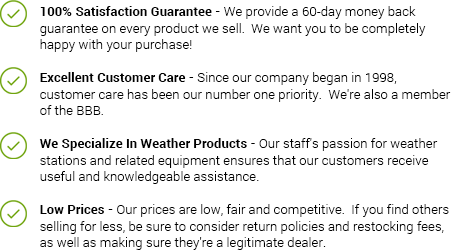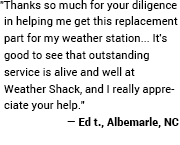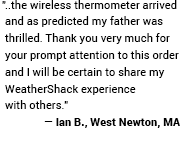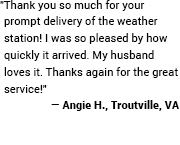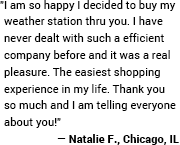
Weather Sensors
A Weather Station Installation Overview Setting up home weather stations is fun, relatively easy, and when completed, rewarding and informative as well. To obtain the most reliable and accurate weather information, it's important to give some thoughtful consideration as to where the various components are located. Though some compromise may be required, following these general guidelines should enable you to place your weather sensors in locations that will result in accurate and useful readings. Ideally, weather sensors should be sited out in the open and away from objects that may affect measurement accuracy. Depending on your situation, features such as landscaping and/or building structures can significantly impact the location where your sensors can be sited. Of course cable length (cabled weather stations) or transmitter range (wireless weather stations) will also limit the locations available for placing weather sensors. A major factor affecting placement of wireless weather sensors is their Transmission Range, the maximum distance between the console receiver and remote transmitting sensor. Manufacturers base this rating upon "open air," meaning a line of sight path with no obstructions (walls, etc.) between components. Of course the signal will have to penetrate building materials in most installations, so to estimate the maximum "effective" range between those components the rule of thumb is 1/3 to 1/2 of the open air rating. As an example, if a system has a open air transmission range of 330 feet, the estimated maximum effective range is 110 to 150 feet between outdoor sensor and indoor console. The optimum placement for each type of sensor is different. Thermometers and Hygrometers should be installed from four to six feet above the ground in a shaded location (not under trees!). If the thermometer hygrometer is placed on a building, select a location below the eaves on a north facing wall, which will provide shade and some shelter from rain. |
Rain Gauges should be sited out in the open and relatively close to the ground (two feet above is optimal), then leveled. This placement makes it convenient to clean the rain gauge should it become obstructed by debris. Anemometers should be sited in a location where the wind flows freely (such as roof mount) and oriented to true north as instructed by the manufacturer. The standard height of an anemometer is 10 meters (33 feet) above ground. Given the difference in siting recommendations between anemometers and rain gauges, mounting them together should be avoided. The Indoor Console should be located where it's convenient to see and use it. Barometers are typically housed in the console and some consideration should be given to that barometer when determining console placement. Linking to a computer or other equipment will likely narrow those options. For the installation of wireless weather stations, it's a good idea to put it near an outside wall and as close as possible to the remote sensors. Remember that radio signal strength will be reduced by each layer of building material the signals must penetrate. Be extremely careful when installing your weather stations components and follow all procedures recommended by the manufacturer. Use caution and common sense, Safety First! When installing a mast for anemometers, keep in mind the danger of falling or coming into contact with power lines. Be aware too that any elevated metal pole can act like a lightning rod so be sure to ground it properly. Failure to do so could prove to be deadly. All content on the WeatherShack Education Center is Copyright 2002-2020 WeatherShack.com. This material may not be reproduced, displayed, modified or distributed without the express prior written permission of WeatherShack.com. For permission, please contact [email protected]. |

